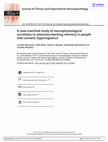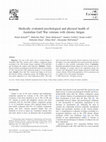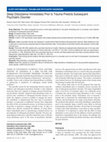Papers by Alexander McFarlane

Objective: Somatic hypervigilance describes a clinical presentation in which people report more, ... more Objective: Somatic hypervigilance describes a clinical presentation in which people report more, and more intense, bodily sensations than is usual. Most explanations of somatic hypervigilance implicate altered information processing, but strong empirical data are lacking. Attention and working memory are critical for information processing, and we aimed to evaluate brain activity during attention/working memory tasks in people with and without somatic hypervigilance. Method: Data from 173 people with somatic hypervigilance and 173 controls matched for age, gender, handedness, and years of education were analyzed. Event-related potential (ERP) data, extracted from the continuous electroencephalograph recordings obtained during performance of the Auditory Oddball task, and the Two In A Row (TIAR) task, for N1, P2, N2, and P3, were used in the analysis. Betweengroup differences for P3 amplitude and N2 amplitude and latency were assessed with two-tailed independent t tests. Between-group differences for N1 and P2 amplitude and latency were assessed using mixed, repeated measures analyses of variance (ANOVAs) with group and Group × Site factors. Linear regression analysis investigated the relationship between anxiety and depression and any outcomes of significance. Results: People with somatic hypervigilance showed smaller P3 amplitudes-Auditory Oddball task: t(285) = 2.32, 95% confidence interval, CI [3.48, 4.47], p = .026, d = 0.27; Two-In-A-Row (TIAR) task: t(334) = 2.23, 95% CI [2.20; 3.95], p = .021, d = 0.24-than case-matched controls. N2 amplitude was also smaller in people with somatic hypervigilance-TIAR task: t (318) = 2.58, 95% CI [0.33, 2.47], p = .010, d = 0.29-than in case-matched controls. Neither depression nor anxiety was significantly associated with any outcome. Conclusion: People with somatic hypervigilance demonstrated an event-related potential response to attention/working memory tasks that is consistent with altered information processing.
Addictive Behaviors, 2006
Good faith, a little one; not past a pint, Good faith, a little one; not past a pint, as I am a s... more Good faith, a little one; not past a pint, Good faith, a little one; not past a pint, as I am a soldier as I am a soldier (Othello, Act 2, Scene 3) (Othello, Act 2, Scene 3)

Journal of Psychosomatic Research, 2006
Objective: The aim of this study was to evaluate fatigue in Australian Gulf War veterans and a mi... more Objective: The aim of this study was to evaluate fatigue in Australian Gulf War veterans and a military comparison group according to the 1994 chronic fatigue syndrome (CFS) definition and investigate the relation with exposures. Methods: Comprehensive medical, psychological and reported exposure assessments of 1456 veterans and 1588 comparison group in a cross-sectional study. Results: More Gulf War veterans had fatigue at all levels than did the military comparison group. The findings may be at least partly explained as an bactive-deployment effect.Q The odds ratios increased with increasing clinical evaluation of the nature of the fatigue, even after adjustment for current psychiatric disorders in addition to other possible confounding factors. Conclusion: Medically unexplained chronic fatigue was more common, but not more disabling, in veterans than in the comparison group, but veterans with unexplained chronic fatigue had poorer health than veterans without. Within both populations, CFS is uncommon and at a similar level to the general community. D
Journal of Traumatic Stress, 2005
Psychological Injury and Law, 2010

The Medical journal of Australia
To describe Australian medical graduates' knowledge, experiences and practical training i... more To describe Australian medical graduates' knowledge, experiences and practical training in rheumatology and their attitudes towards rehabilitation and disability. Cross-sectional survey of all interns at randomly selected hospitals in each State. 382 Australian interns at 12 hospitals surveyed in the first week of their 1991 internship. New interns demonstrated little experience with soft tissue rheumatism, with only 45% reporting they had examined a patient with bursitis and 22% one with epicondylitis. There was considerable dissatisfaction with the teaching of assessment of low back pain, regardless of the amount of formal rheumatology teaching the graduates had experienced, with only 22% rating it as good or excellent. There was little evidence that students are exposed to the social dimensions of chronic illness; only 32% of students reported that they had been shown how to assess a patient's psychological adjustment to illness. Only 22% felt competent at assessing disability and handicap and less than half of the graduates studied had ever attended a clinic where there was a physiotherapist. Graduates who had never been attached to either a rheumatology ward or an outpatients clinic (17%) were less likely to have examined a patient with gout (P < 0.001), osteoarthritis (P < 0.01), or chronic low back pain (P < 0.05), and were more likely to report dissatisfaction with training in rheumatology. This survey suggests that there are significant problems in the training of medical students in musculoskeletal disorders, particularly in relation to the assessment of disability and the appreciation of psychosocial factors.

The Journal of Clinical Psychiatry
Posttraumatic stress disorder (PTSD) differs from other anxiety disorders in that experience of a... more Posttraumatic stress disorder (PTSD) differs from other anxiety disorders in that experience of a traumatic event is necessary for the onset of the disorder. The condition runs a longitudinal course, involving a series of transitional states, with progressive modification occurring with time. Notably, only a small percentage of people that experience trauma will develop PTSD. Risk factors, such as prior trauma, prior psychiatric history, family psychiatric history, peritraumatic dissociation, acute stress symptoms, the nature of the biological response, and autonomic hyperarousal, need to be considered when setting up models to predict the course of the condition. These risk factors influence vulnerability to the onset of PTSD and its spontaneous remission. In the majority of cases, PTSD is accompanied by another condition, such as major depression, an anxiety disorder, or substance abuse. This comorbidity can also complicate the course of the disorder and raises questions about the role of PTSD in other psychiatric conditions. This article reviews what is known about the emergence of PTSD following exposure to a traumatic event using data from clinical studies.
The Medical journal of Australia
The public myth of the discovery of penicillin is an archetypal "quest story" of the type common ... more The public myth of the discovery of penicillin is an archetypal "quest story" of the type common to every human culture. But the real story of the discovery, testing and refinement of penicillin is a complex tale of accident, serendipity, oversight, conflict, the pressure of war, idiosyncratic personalities and even -the invention of history.
The Medical journal of Australia

Journal of Affective Disorders, 2016
Contention in the literature regarding the diagnostic utility of intrusion symptoms highlights th... more Contention in the literature regarding the diagnostic utility of intrusion symptoms highlights that they have high sensitivity but low specificity in predicting PTSD. They are highly prevalent following a range of traumatic events, and across a range of disorders. The prevalence of intrusion symptoms in the absence of PTSD suggests their relevance to the development of other psychopathology. Therefore, the predictive role of intrusion symptoms for other post-trauma psychopathology was examined using data from an epidemiological, longitudinal sample of adults recruited in childhood. From 5 phases of data collection for this sample, these analyses focused on the 20 year and 28 year follow-ups (n=583). Lifetime exposure to trauma was assessed using a modified set of 10 Criterion-A events from the Composite International Diagnostic Interview (CIDI), with PTSD assessed in reference to a self-nominated worst lifetime event, and other DSM-IV disorder also assessed using the CIDI. Results showed that the presence of intrusion symptoms without PTSD at the 20 year follow-up was predictive of increased risk at 28 years for depressive but not anxiety disorders. There was limited psychopathology in the sample, reducing the power to examine many individual disorders. Furthermore, trauma history and psychiatric symptoms were retrospectively reported, introducing the possibility of recall bias. Together the findings suggest that intrusion symptoms may play an aetiological role in the development and/or maintenance of disorders other than PTSD.
Journal of Military and Veterans' Health
JBI database of systematic reviews and implementation reports, Jan 15, 2015
The Journal of Rheumatology
American Journal of Psychiatry

Sleep
study Objectives: This study investigated the extent to which sleep disturbance in the period imm... more study Objectives: This study investigated the extent to which sleep disturbance in the period immediately prior to a traumatic event predicted development of subsequent psychiatric disorder. Design: Prospective design cohort study setting: Four major trauma hospitals across Australia Patients: A total of 1033 traumatically injured patients were initially assessed during hospital admission and followed up at 3 months (898) after injury Measures: Lifetime psychiatric disorder was assessed in hospital with the Mini-International Neuropsychiatric Interview. Sleep disturbance in the 2 weeks prior to injury was also assessed using the Sleep Impairment Index. The prevalence of psychiatric disorder was assessed 3 months after traumatic injury. results: There were 255 (28%) patients with a psychiatric disorder at 3 months. Patients who displayed sleep disturbance prior to the injury were more likely to develop a psychiatric disorder at 3 months (odds ratio: 2.44, 95% CI: 1.62-3.69). In terms of patients who had never experienced a prior disorder (n = 324), 96 patients (30%) had a psychiatric disorder at 3 months, and these patients were more likely to develop disorder if they displayed prior sleep disturbance (odds ratio: 3.16, 95% CI: 1.59-4.75). conclusions: These findings provide evidence that sleep disturbance prior to a traumatic event is a risk factor for development of posttraumatic psychiatric disorder.






Uploads
Papers by Alexander McFarlane